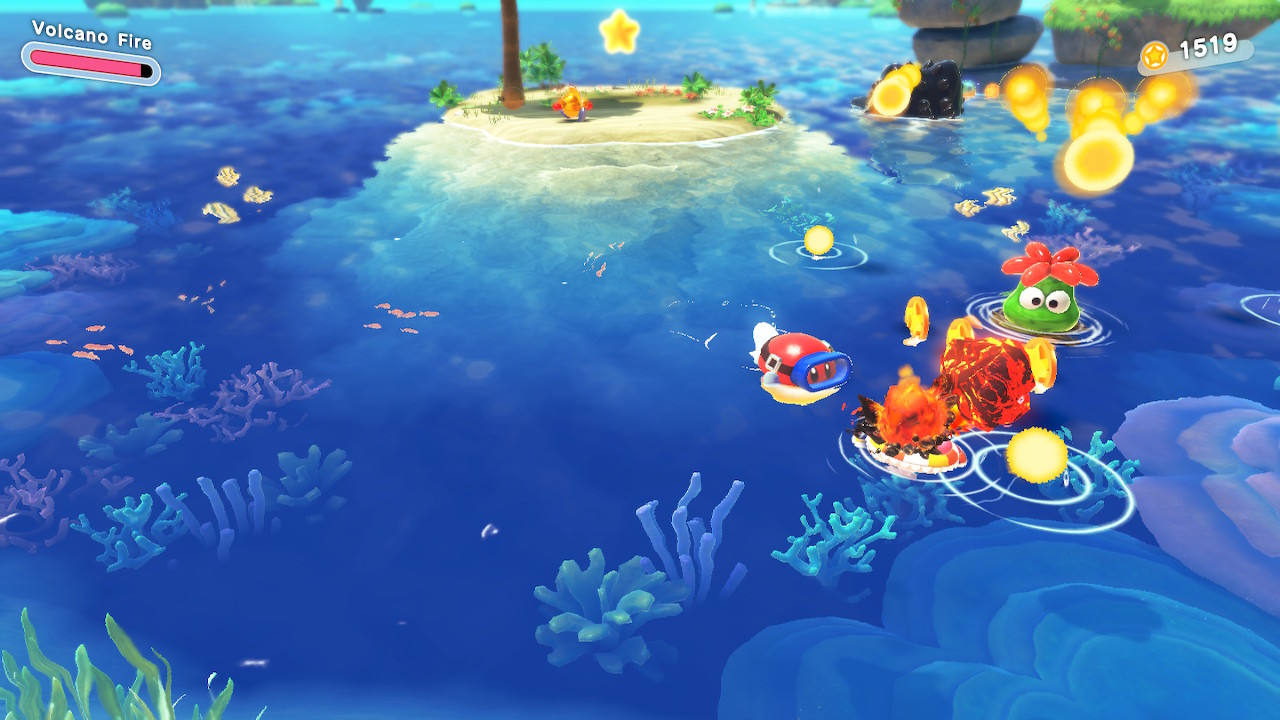Kirby has been eating all the things in his way for a while. Like a floofy Pac-Man with more agency, the pink cloud’s voracious appetite has remained remarkably consistent since his debut on the Game Boy in 1992. Kirby devours stuff, then either spits it out at high velocity or swallows it to absorb its essence.
Being Kirby’s 30th anniversary and all, it’s no surprise Nintendo whipped up a new adventure on the Switch. Kirby and the Forgotten Land ventures into a full-on 3D landscape and, in the process, ends up being the most classically Nintendo-style 3D platformer in years. Gameplay-wise, this is a mostly back-to-basics adventure; Kirby finds himself trapped in a mysterious new world with new friends to rescue and plenty of bad guys in need of consumption.
Kirby and the Forgotten Land Review: Nintendo’s Most Endearing Vore is Back for More
This is the first time Kirby has gone full-on 3D (not counting the odd spin-off), and HAL Laboratory certainly played it safe. Forgotten Land looks, plays, and feels like a quintessential Nintendo 3D platformer, arguably more than any of their other Switch games so far. Individual map zones are divided into multiple levels on the world map, and each tries to have a different feel than the last.
None of the levels are huge, but they have a list of secrets to uncover to rescue all the trapped Waddle Dees. Collect enough Waddle Dees, and side levels open with special challenges to earn ability upgrade gems. Some of the levels are pure run and jump, but most are spiced up with vehicle segments, chase bits, and mini-boss fights. There are puzzle rooms to find, plenty of gold coins to collect, and health-giving food to inhale.
A big part of why this Kirby adventure feels so classic is the camera, which is almost entirely locked. It shows you exactly the view it wants, with only minor panning allowed. This leads to secrets being “hidden” simply because you can’t move the camera to see them. The locked camera really does change the pace and gameplay experience, making it feel a bit more simplistic and accessible.
There are seven worlds in Forgotten Land, although the last is really just a boss fight. The other worlds contain four or five main levels, a boss fight, and multiple Treasure Road trial side-levels. Past the opening sequence, two players can take on the adventure as well (one as Kirby, the second as a special Waddle Dee), making it a much more appealing coop game than Mario Odyssey, where player two could just be a hat.

Kirby has always been a more accessible sort, with fun and charming adventures relatively easy for all ages. Forgotten Land celebrates this history by offering an easier mode and a “Wild” mode. Honestly, the Wild mode (the default difficulty) doesn’t feel too wild outside of certain bits like timed sequences and a couple of boss fights might prove a problem for some youngsters. Suffice to say, Kirby remains accessible.
This easier pace is actually rather refreshing. Forgotten Land is a fun place in which to bump around and explore, and the variety of abilities Kirby can suck up adds to the enjoyment. Some levels and sequences require a certain ability type, but largely, Kirby can come in with a chosen suit and swap around at will (or not).
There are new forms like the Ranger and drill, and both strange and familiar ones like fire, ice, whirlwinds, spikes, hammer-bashers, and plenty more. What’s more, upgrade blueprints for each are hidden in levels. These can be used in the central Waddle Dee town to level up each individual form.
Newly added is the hilariously weird “mouthful” mode. Here Kirby can suck up specific objects that are definitely not doctor approved. From a racing car and glider to a traffic cone, moving stairway, and even a wall of lockers, these are vital for getting through certain sections and finding secrets.
Kirby and the Forgotten Land Review — The Bottom Line
Pros
- Excellent array of different forms to swallow and upgrade.
- Plenty of fun and diverse levels and landscapes.
- Adorably cute and accessible, with lots of secrets and clever bits.
Cons
- For those in search of the hardcore, Kirby is not the game.
- Some glitches and nearly non-existent camera controls.
- Visual presentation is ok, but certainly not cutting edge.
Kirby and the Forgotten Land looks largely like all of Nintendo’s first-party Switch games. There are some picturesque sights and everything is adorably cute, but the visuals and overall graphic style and fidelity are starting to look a bit stagnant. Some odd frame-rate hiccups were especially noticeable when playing in docked mode.
The soundtrack is suitably boppy and smooth, with some surprisingly good scoring and fun sound effects. Character design is a mix of old and new, with a lot of enemies highly reminiscent of those from previous games if not outright copies. There’s even the old standby angry giant tree and maniacal penguin to fight.
Overall, Kirby and the Forgotten Land is exactly the sequel we’d expect. Despite the move to 3D, the gameplay is instantly familiar. While nothing here is anything close to groundbreaking or even innovative, it is a comfortable, casual, all-ages adventure worth taking.
[Note: Nintendo provided the copy of Kirby and the Forgotten Land used for this review.]









Published: Apr 2, 2022 01:56 pm